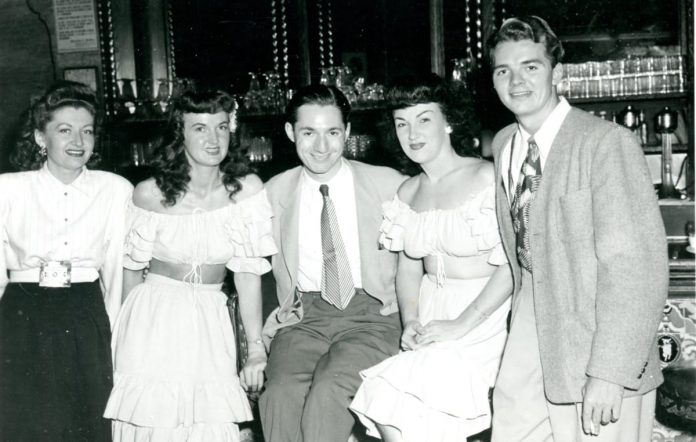
Arv’s last recordings in 1948 were for the Metro label. The label was short-lived, and distribution was limited for the two 78 singles that featured fellow Toledoan El Myers on piano and vocals. The Metro singles were Arv’s only recordings as leader where is he credited as the Arv Garrison Trio.
Some of Arv Garrison’s most accomplished performances were recorded for the Armed Forces Radio Service on Jubilee transcriptions. Arv Garrison performed singly and with the Vivien Garry Trio on five transcriptions that were recorded in March, May and November of 1946. The Jubilee recording sessions at NBC and CBS studios in Hollywood before appreciative audiences reached the ears of service personnel around the world, but were not broadcast to or heard by fans in the United States.
AFRS established another transcription series in 1945 named Magic Carpet in honour of returning service personnel from overseas. West Coast fans who tuned in to these ABC remotes on their radios late at night could have heard Arv performing with the Vivien Garry trio during their May-June 1946 engagement at Hollywood’s Club Morocco. AFRS released five transcriptions from the Club Morocco broadcasts, once again for overseas distribution and not heard by fans in the United States. Wini Beatty was the pianist in the trio during this time. The exchanges between Wini and Arv on How High The Moon display some of Garrison’s most nimble finger work on the tune that he could rightly call his own, as captured on Magic Carpet 332.
The Vivien Garry Trio were guests on Gene Norman’s Mild And Mellow programme on KMPC while they were performing at the Tabu Club in Hollywood, November 1946. The aircheck from Vivien Garry’s private collection presents Garry, Beatty, and Garrison spurring each other on in a romping version of Mop Mop. Another aircheck from Garry’s archive captured their 30-minute appearance on Art Ford’s Saturday Night Swing Session on WNEW in May of 1947. Teddy Kaye had returned to the trio during their engagement at The Famous Door in New York. Unhindered by the constraints of a 78 single recording session, all members of the trio could stretch out and display their remarkable chops during the broadcast.
Garrison’s recorded legacy on the 19 singles issued during his three active years were either under the shadow of his wife, Vivien Garry, or as sideman for other leaders that included Charlie Parker, Dizzy Gillespie, Howard McGhee and Earle Spencer – barely the output to establish a lasting memory with jazz fans. Arv was well served by the media with good reviews of his nightclub performances in Metronome and Downbeat that included a cover photo on the 1 July 1946, issue of Downbeat. He also placed quite well in the Metronome and Downbeat polls. But print media is temporary and fleeting, unlike a 78 single that you can play when the mood strikes you.
Arv Garrison suffered from epilepsy. He was able to perform despite the occasional seizures that his trio mates noticed during their time in California. The seizures became more frequent and pronounced when the Vivien Garry Trio returned to New York.
Arv’s earlier playing had displayed his exceptional gift of communicating commands in milliseconds from his brain to his fingers. Epilepsy robbed him of that facility. The trio dissolved when Vivien returned to California when her father took was taken ill. Arv returned to Toledo and his parent’s home at 3346 Upton Avenue. His career was over.
Arv Garrison’s peers, such as his close friend Irving Ashby, continued their performance and recording careers, creating and sustaining an awareness in the minds of jazz fans. Arv’s sparse outings on record failed to establish that same awareness. His name disappeared from the jazz polls. Arv Garrison today remains mostly unknown to the jazz public.
The Unknown Arv Garrison: “Wizard of the Six String” was released by Fresh Sound Records in May 2021. The three-CD slipcase set presents almost all of Arv Garrison’s recordings during his brief career. It includes the Metro sides, but the initial Premier recordings could not be found. In addition to the rare AFRS transcriptions, the set includes the equally rare airchecks described above. The 76-page booklet reproduces a portrait of Arv Garrison that was written by Toledo native, Bob Dietsche, in an extended article for the Toledo Magazine in June of 1989. Dietsche interviewed Bill Cummrerow, Vivien Garry, Wini Beatty and El Myers who all provided first-hand recollections of their time playing with Arv Garrison. The article provides a haunting portrait of Garrison’s meteoric career.
Bay Area jazz guitarist, bandleader, researcher, author and jazz historian Nick Rossi recently wrote an appreciation of Oscar Moore for the recent Resonance Records release Nat King Cole – Hittin’ The Ramp: The Early Years (1936-1943). His 10-part essay Arv Garrison On Record: 1945-1948 provides the first authoritative chronicle of Arv Garrison, wizard of the six string, to be published. Rossi discusses all of Garrison’s recordings with the unique insight of a working jazz guitarist. The booklet includes many previously unpublished photos from Vivien Garry’s archive, and rare memorabilia from clubs in California and New York.















